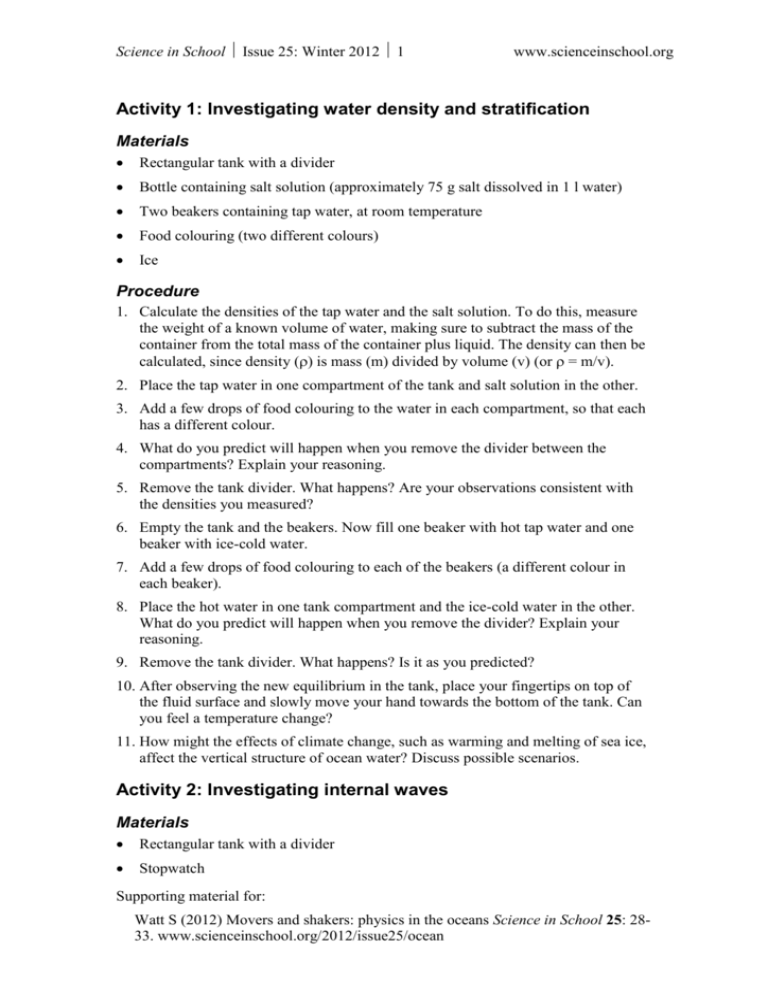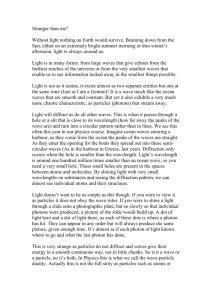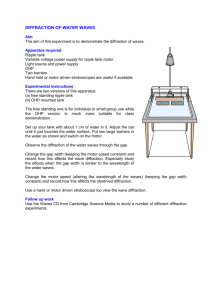Word - Science in School
advertisement

Science in School Issue 25: Winter 2012 1 www.scienceinschool.org Activity 1: Investigating water density and stratification Materials Rectangular tank with a divider Bottle containing salt solution (approximately 75 g salt dissolved in 1 l water) Two beakers containing tap water, at room temperature Food colouring (two different colours) Ice Procedure 1. Calculate the densities of the tap water and the salt solution. To do this, measure the weight of a known volume of water, making sure to subtract the mass of the container from the total mass of the container plus liquid. The density can then be calculated, since density ( is mass (m) divided by volume (v) (or = m/v). 2. Place the tap water in one compartment of the tank and salt solution in the other. 3. Add a few drops of food colouring to the water in each compartment, so that each has a different colour. 4. What do you predict will happen when you remove the divider between the compartments? Explain your reasoning. 5. Remove the tank divider. What happens? Are your observations consistent with the densities you measured? 6. Empty the tank and the beakers. Now fill one beaker with hot tap water and one beaker with ice-cold water. 7. Add a few drops of food colouring to each of the beakers (a different colour in each beaker). 8. Place the hot water in one tank compartment and the ice-cold water in the other. What do you predict will happen when you remove the divider? Explain your reasoning. 9. Remove the tank divider. What happens? Is it as you predicted? 10. After observing the new equilibrium in the tank, place your fingertips on top of the fluid surface and slowly move your hand towards the bottom of the tank. Can you feel a temperature change? 11. How might the effects of climate change, such as warming and melting of sea ice, affect the vertical structure of ocean water? Discuss possible scenarios. Activity 2: Investigating internal waves Materials Rectangular tank with a divider Stopwatch Supporting material for: Watt S (2012) Movers and shakers: physics in the oceans Science in School 25: 2833. www.scienceinschool.org/2012/issue25/ocean Science in School Issue 25: Winter 2012 2 www.scienceinschool.org Food colouring or other appropriate dye Two containers: one with fresh water and the other with dyed salt water (approximately 75g salt dissolved in 1 l tap water) Wave paddle (a wide piece of plastic about 2 cm high, with a width similar to that of the tank) Optional: a piece of plastic the same width as the tank but about one-third of its length Procedure 1. Place the tap water in one compartment of the tank and the coloured salt solution in the other. 2. Remove the divider between the compartments, and watch what happens. Make a note of any waves you see, and describe their movements. 3. Identify the internal wave – this travels back and forth along the interface between the two differently coloured fluids. Measure the speed of this wave by timing how long it takes for the wave to travel the length of the tank. (Make sure you use an average value by timing several traverses.) Find the speed of the wave using the formula: Length of tank (m) / time taken (s) = wave speed (m/s) 4. Try producing surface and internal waves using the wave paddle. For surface waves, lower the paddle into the water and raise it again, repeating the cycle at a fast frequency (at least once a second). For internal waves, do this more slowly (about once every 10 seconds). 5. Discuss your results. 6. Optional: if you have time, you can repeat the experiments using the piece of plastic inserted at an angle to the bottom of the tank, to give the effect of a shallow sea bed. Place the plastic in position as shown below. Supporting material for: Watt S (2012) Movers and shakers: physics in the oceans Science in School 25: 2833. www.scienceinschool.org/2012/issue25/ocean Science in School Issue 25: Winter 2012 3 www.scienceinschool.org An internal wave at the interface between the denser (blue) salt water and less dense (clear) water. A wave paddle is shown on the right of the tank, and a piece of plastic to simulate shallow topography on the left. Image courtesy of Lee Karp-Boss Discussion The energy of internal waves is generally lower than that of surface waves. This is because the gravitational restoring force is smaller for internal waves, due to the relatively slight difference in density between water layers (compared to that between water and air for surface waves). This lower energy means that, for a tank (or water basin) of a given size, the natural frequency of the internal waves will also be lower than for surface waves. In additional to surface waves, stratified fluids support internal waves; in two-layer fluids, these waves ride on top of the interface between the two fluids. Their periods are significantly longer than those of surface waves and their amplitudes can be significantly higher. When we perturb the two-layer system, many waves are initially excited, but only those that fit (resonate) with the geometry of the basin remain. Inserting the piece of plastic at one end of the tank, simulating an increasingly shallow seabed, can cause internal waves to break, similar to surface waves breaking on a beach, but occurring below the surface. Supporting material for: Watt S (2012) Movers and shakers: physics in the oceans Science in School 25: 2833. www.scienceinschool.org/2012/issue25/ocean








